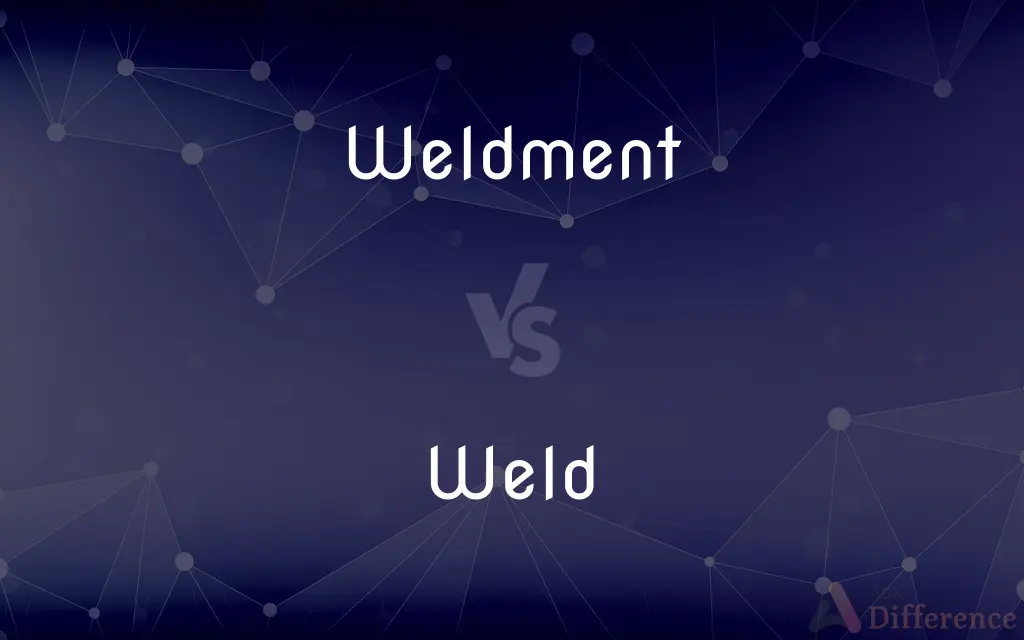Weldment vs. Weld — What's the Difference?
By Maham Liaqat & Urooj Arif — Updated on March 29, 2024
Weldment refers to an assembly created by welding together multiple pieces, emphasizing the structure, while a weld is the process or result of joining metals by melting them together.

Difference Between Weldment and Weld
Table of Contents
ADVERTISEMENT
Key Differences
Weldment is a term used to describe an assembly that consists of several components or pieces joined together through the welding process. It emphasizes the structural aspect of the assembly, showcasing the complexity and design of the fabricated structure. On the other hand, a weld specifically refers to the process of joining metals (or thermoplastics) by melting and fusing them together, along with a filler material, to form a strong bond.
In terms of application, weldments are commonly found in industries where structural integrity and design complexity are critical, such as construction, automotive, and aerospace. These structures are designed with specific purposes in mind, incorporating various shapes and sizes of metal parts. Whereas, welding as a process is utilized across a wide range of applications beyond creating weldments, including repair work, manufacturing, and art, making it a fundamental skill in metalworking.
The creation of a weldment typically involves multiple welding operations, incorporating various types of welds (e.g., butt, fillet, groove) depending on the design requirements and the materials being joined. Conversely, a weld refers to the individual operation and its outcome within the broader context of metal fabrication or repair, focusing on the technique and the quality of the joint produced.
Weldments are evaluated based on the overall design, the strength of the assembly, and how well the components are integrated and function together. In contrast, a weld is assessed based on criteria such as penetration, strength, and the absence of defects, with the quality of a weld being critical to the integrity of the individual joint and, by extension, the entire structure.
The terminology reflects the scope of work: "weldment" implies a project involving multiple welds and components, showcasing the complexity and engineering behind the assembly. Meanwhile, "weld" signifies the technical aspect of joining materials, emphasizing the method and quality of the bond formed between them.
ADVERTISEMENT
Comparison Chart
Definition
An assembly of pieces joined by welding.
The process or result of joining metals by melting.
Focus
Structural assembly and design.
Technique and quality of joining materials.
Application
Construction, automotive, aerospace industries.
Broad, including manufacturing, repair, and art.
Evaluation
Based on design, strength, and integration.
Based on penetration, strength, and absence of defects.
Terminology
Reflects complexity and engineering.
Focuses on the method and quality of the bond.
Compare with Definitions
Weldment
A structural component in architecture.
The building's entrance featured a complex steel weldment.
Weld
A process of joining steel beams.
The weld between the beams ensured the structure's stability.
Weldment
A fabricated platform in industrial equipment.
The conveyor system was built on a sturdy weldment.
Weld
Repairing a crack in metal through welding.
A precise weld was required to fix the crack in the tank.
Weldment
Custom furniture made from metal sections.
The artist created a unique chair as a decorative weldment.
Weld
Fabricating a custom metal gate.
The gate's design featured intricate welds for decorative purposes.
Weldment
A metal frame constructed for machinery.
The weldment for the printing press was designed to support heavy loads.
Weld
The fusion of metal parts in artwork.
Each weld in the sculpture added to its intricate detail.
Weldment
A framework used in automotive chassis.
The car's safety cage is a critical weldment in its design.
Weld
Joining pipes in plumbing work.
A leak-proof weld was essential for the water system's integrity.
Weldment
A unit composed of an assemblage of pieces welded together.
Weld
To join (metals) by applying heat, sometimes with pressure and sometimes with an intermediate or filler metal having a high melting point.
Weldment
A part created from an assembly of smaller components that are joined by welding.
Weld
To bring into close association or union.
Weldment
An assembly of parts welded together
Weld
To be capable of being welded.
Weld
The union of two metal parts by welding.
Weld
The joint formed by welding.
Weld
See dyer's rocket.
Weld
The yellow dye obtained from dyer's rocket.
Weld
A herb (Reseda luteola) related to mignonette, growing in Europe, and to some extent in America, used to make a yellow dye.
Weld
The yellow coloring matter or dye extracted from this plant.
Weld
The joint made by welding.
Weld
(transitive) To join two materials (especially two metals) together by applying heat, pressure and filler, either separately or in any combination.
Weld
(transitive) To bind together inseparably; to unite closely or intimately.
The arrows pierced through the welded ranks of the opposing army.
Weld
To wield.
Weld
To wield.
Weld
To press or beat into intimate and permanent union, as two pieces of iron when heated almost to fusion.
Weld
Fig.: To unite closely or intimately.
Two women faster welded in one love.
Weld
An herb (Reseda luteola) related to mignonette, growing in Europe, and to some extent in America; dyer's broom; dyer's rocket; dyer's weed; wild woad. It is used by dyers to give a yellow color.
Weld
Coloring matter or dye extracted from this plant.
Weld
The state of being welded; the joint made by welding.
Weld
European mignonette cultivated as a source of yellow dye; naturalized in North America
Weld
United States abolitionist (1803-1895)
Weld
A metal joint formed by softening with heat and fusing or hammering together
Weld
Join together by heating;
Weld metal
Weld
Unite closely or intimately;
Her gratitude welded her to him
Common Curiosities
What criteria are used to assess a weld?
A weld is assessed based on penetration, strength, and the absence of defects.
What evaluates the quality of a weldment?
The quality of a weldment is evaluated based on its design, the integration and strength of its components.
Can a single weld create a weldment?
Typically, a weldment consists of multiple welds and components; a single weld doesn’t constitute a weldment.
How do weldments and welds differ in application?
Weldments are used in creating complex assemblies in industries like construction, while welds are applied broadly in manufacturing, repair, and art.
Is welding only used in industrial settings?
While prevalent in industrial settings, welding is also used in art, repair work, and DIY projects.
Can welding techniques vary depending on the project?
Yes, welding techniques can vary widely, including MIG, TIG, and arc welding, depending on the materials and project requirements.
What is a weld?
A weld refers to the process or the result of joining metals or thermoplastics by melting them together.
What is a weldment?
A weldment is an assembly made by welding together multiple pieces, focusing on the structural aspect.
What materials can be welded?
Materials that can be welded include various metals and thermoplastics, depending on the welding technique.
Why is the quality of a weld important?
The quality of a weld is crucial for the integrity and strength of the joint and the overall structure it’s part of.
What skills are required for welding?
Welding requires skills in metalworking techniques, understanding of materials, and the ability to use welding equipment.
Are all metal structures considered weldments?
Not all metal structures are considered weldments; the term specifically refers to those assembled through welding.
How do the purposes of weldments and welds differ?
Weldments serve structural and design purposes in assemblies, while welds focus on the act of joining materials and the strength of those joints.
How do weldments contribute to construction?
In construction, weldments provide essential structural components that contribute to the strength and integrity of buildings and infrastructure.
What role does welding play in manufacturing?
Welding plays a critical role in manufacturing, allowing for the fabrication of a wide range of products and structures through the durable joining of materials.
Share Your Discovery

Previous Comparison
Prose vs. Sonnet
Next Comparison
Potty vs. PoopAuthor Spotlight
Written by
Maham LiaqatCo-written by
Urooj ArifUrooj is a skilled content writer at Ask Difference, known for her exceptional ability to simplify complex topics into engaging and informative content. With a passion for research and a flair for clear, concise writing, she consistently delivers articles that resonate with our diverse audience.














































